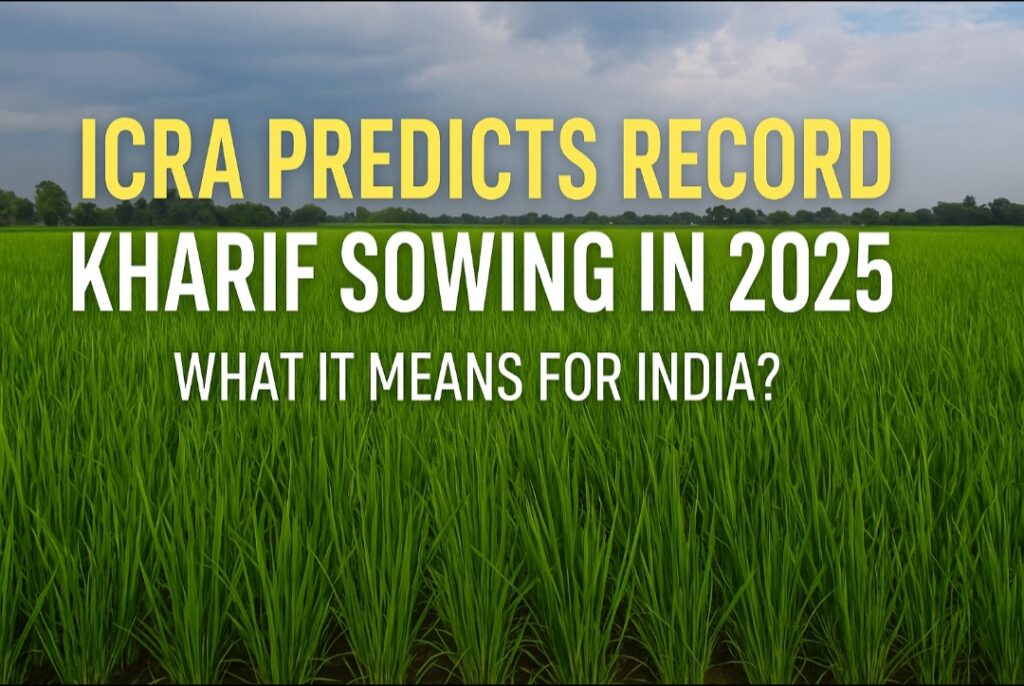ICRA Kharif Crops Report 2025: Sowing to Surpass Last Year?
Indian agriculture is once again under the spotlight, and this time, it’s the Kharif crops sowing data that’s making headlines. According to the latest report by ICRA, the sowing activity this season may actually exceed last year’s level. That’s huge, especially when monsoon patterns have been anything but predictable.
Why Is Kharif Sowing Such a Big Deal in India?
If you’re not from a farming background, here’s a quick snapshot:
- Kharif crops are sown with the onset of the monsoon – typically around June-July.
- They include staples like paddy (rice), soybean, cotton, maize, and pulses.
- These crops are rain-fed, which means timely and well-distributed rainfall is critical.
Now, imagine the impact if sowing rises – it signals improved agri-income, rural spending, and possibly food inflation stability.

🔍 ICRA’s Findings: What’s New This Year?
1. Early Monsoon Boosts Farmer Confidence
ICRA reports a faster sowing pace compared to 2024, thanks to early and widespread monsoon rainfall across major agricultural states like Maharashtra, Madhya Pradesh, and Uttar Pradesh.
2. Paddy, Pulses, and Coarse Grains See Uptick
According to field-level data, sowing of major kharif crops – especially paddy and pulses – has picked up strongly:
- Paddy acreage has expanded by 7.2% YoY as of July-end.
- Pulses saw a 9% jump, driven by strong MSP (Minimum Support Price) incentives.
- Oilseeds and coarse grains are also tracking higher than last year.
3. Policy Push & MSP Impact
The Government of India’s proactive hike in MSPs and timely release of water from reservoirs played a crucial role in energizing rural agri activity.
📈 What This Means for the Economy
- Better rural income = higher consumption in Tier 2 & 3 cities.
- Likely downward pressure on food inflation if monsoon stays favourable.
- Boost to allied sectors like fertilizers, agri-machinery, and rural banking.
As this Financial Express report suggests, a strong kharif season can indirectly support India’s GDP in Q2 and Q3 of FY26.
🌧️ But What About Monsoon Risks?
1. Uneven Distribution Still a Worry
While rainfall volumes look good overall, certain regions have reported excess rains while others faced temporary drought spells. This uneven pattern could impact yields even if sowing is higher.
2. Groundwater Replenishment Is Crucial
Increased sowing is good, but if groundwater isn’t recharged adequately, late-stage crop development may suffer.

🧠 Expert Take: What Should You Watch Next?
As an agri analyst, here’s what I’m closely tracking:
- Rainfall in August – the most critical month for crop development
- State-wise sowing updates from Ministry of Agriculture
- Government intervention via buffer stock management
- Commodity price trends – especially rice, pulses, and edible oils
📌 Final Thoughts: Is This a Turning Point?
The ICRA kharif crops report clearly signals optimism in Indian agriculture. But real impact will depend on:
- Rainfall consistency through August-September
- MSP procurement efficiency
- Global commodity price movements
Still, the signs are encouraging – and if trends hold, 2025 could well be a milestone kharif season for the country.
📣 What’s Your Take?
Are you seeing any local sowing trends? Are the rains helping farmers in your region? Drop your thoughts in the comments! 👇
And if you found this article insightful, don’t forget to share it with your network and check out our related post on “Rabi vs Kharif Crops: What Every Indian Should Know”.

